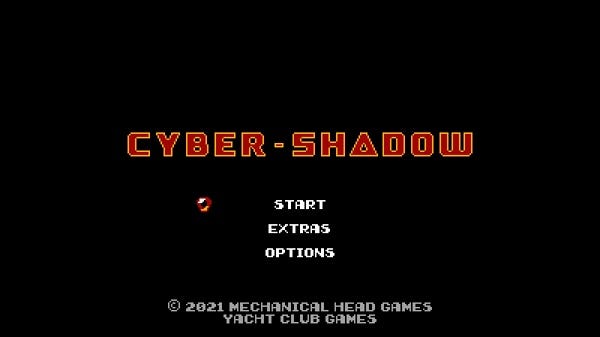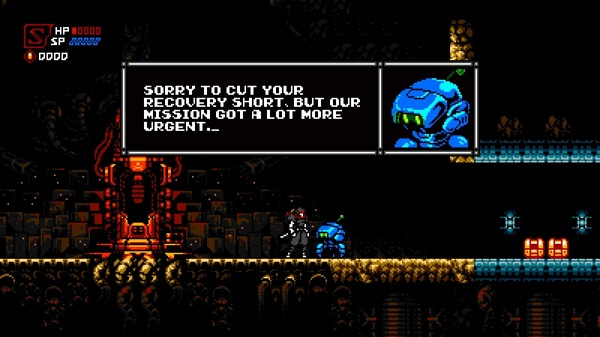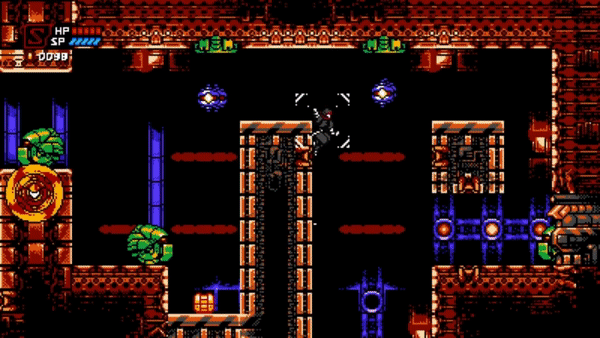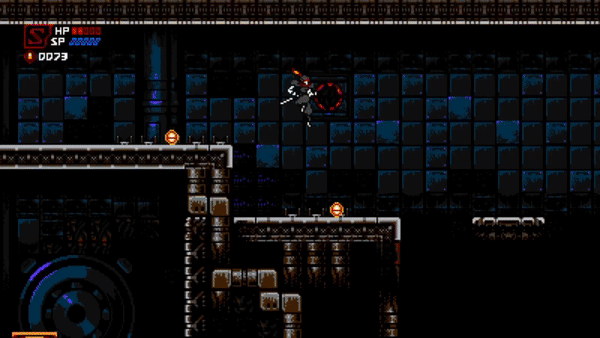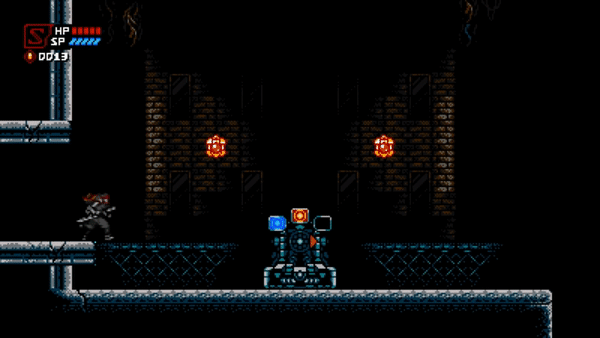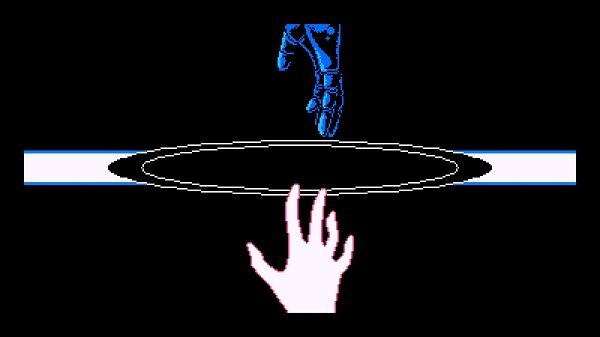Overview
Cyber Shadow is a pixel art 2D action platformer developed by Mechanical Head Studios and published by Shovel Knight developer Yacht Club Games. The game released on January 26, 2021. It follows the footsteps of other indie hits like Cave Story, Undertale, Axiom Verge, Iconoclasts, and Stardew Valley in that it was developed by a single person, Aarne Hunziker.
The gameplay and retro aesthetic are clearly a love letter to the 8-bit NES classics like Ninja Gaiden, Mega Man, and Batman: The Video Game. While the game is a functional homage to these titles it also brings a lot of its own depth and innovation to the gameplay styles it seeks to emulate.
Clocking in on the shorter side, according to howlongtobeat.com, Cyber Shadow takes only a little bit more than 8 hours on average to get through the main story. This playtime can be extended a good bit by its above average difficulty as the game includes many punishing platforming sections and some tough boss encounters.
Cyber Shadow is currently available for the following platforms: Nintendo Switch, PC, Playstation 4, Playstation 5, Xbox One, and Xbox Series S|X.
Story
Cyber Shadow’s story is, in my view, a masterclass in delivering a compelling and thought provoking narrative with minimal cutscenes and dialogue. It may even be my favorite aspect of the game. I will outline some story details revealed -very- early on without spoiling any of the major story beats that take place over the course of the game. In Cyber Shadow’s plot you assume the role of the titular Shadow, a cybernetic ninja warrior whose basic mission is to rescue the captured members of his clan and to liberate Mekacity from Dr. Progen and his synthetic army who draw their power directly from the spiritual life essence of their victims.
Despite being a shorter experience, Cyber Shadow accomplishes a great deal of exposition through clever use of a handful of scripted cutscenes and optional dialogue encounters. It also leverages a lot of in-game interactables that provide lore snippets which add context and insight into the main plot and characters.
At the very opening moments of the game the camera follows a small robot descending from the sky and landing in front of a strange machine. It presses a button and the player is shown a cutscene that begins the unraveling of core narrative threads. First, a cybernetic humanoid is seen suspended inside the chamber of the machine. In a moment the figure is replaced with a flesh and bones human man, shrouded in darkness. He opens his eyes slowly looking down at a locket which he clutches tightly in his grasp. A sword, presumably his, leans up against the edge of a balcony. His gaze slowly lifts to reveal his rooftop position and the nighttime skyline of a large city. The city is illuminated only by the lit windows of skyscrapers that fill the cityscape and the shining of a full moon. Then, row by row, the buildings go dark in a power blackout, and a bright explosion of light consumes everything in sight, including the man. The man awakens, his fleshy hands replaced by metal and the city vista replaced by the claustrophobic and dark interior of his life support chamber. The door opens and the robot waits for him outside in a strange subterranean facility.
Immediately I had a series of questions I wanted answers for. Who is the robot? Who is the man? What is the significance of the locket? What is the cause of the explosion? How did Shadow survive? What happened to the city? The story gripped me quickly, and my first action was to race over to the robot hoping to find some answers. It introduced itself as L-GION, and, while it promised answers in time, it spoke cryptically raising even more questions. How does this robot know Shadow? What is the deal with “our master?” What is Shadow’s history and connection to this city and the people who live there? I didn’t know yet, but that’s fair, because everything that I’ve talked about happened in the first 60 seconds of the game.
L-GION would show up somewhat frequently early on to provide more answers, but also more questions. He described an urgent situation where my time was better spent not standing around to ask every question I was curious about. There was a lot I could extrapolate from the environments and from the enemies I was dispatching, but I knew I was only scratching the surface and that the root answers to my questions could only be found at greater depth.
The soft touch in slow rolling the answers to these questions through minimal cutscenes, character dialogue, lore snippets, and evironmental storytelling were greatly appreciated by me. I don’t have a problem with direct storytelling methods, but there is something that feels more engaging and immersive about being handed crumbs and participating in the story as a mystery unfolds around you. I enjoy having to draw lines between events and using fragments to establish large connections in the narrative tissue. It feels like being a lore archaeologist discovering, and having to make sense of, the secrets of the past. I quite like that feeling, and those types of stories generally tend to grab me more.
Zooming out a bit to the themes and motiffs of the overall narrative, Cyber Shadow touches on elements of existentialism, labor, spirituality, and transhumanism. Concepts of devotion, betrayal, and purpose are strongly threaded through and bind each character together in the story. There are a lot of interesting things going on, and for my money, it’s just as rich a story of fiction as it is a gameplay experience. There is a lot of great atmosphere and I personally scavenged through all the lore that I could to glimpse the big picture that connected Cyber Shadow’s setting and characters. There is a lot there to uncover including some well hidden secrets and extremely subtle clues.
If you generally enjoy science fiction that touches on the themes and motiffs I mentioned earlier, as I do, you will probably find a lot to love in this story. It won’t be handed to you though. For the full picture you’ll have to commit yourself to scrounging every room for interactables and exhaust the dialogue of every character you come across. Even then you’ll have to do some detective work and spend some time thinking on what you’ve read. There’s a LOT more to the tale than I have outlined above, but you’ll have to play or watch the game to see the rest. Even if you choose to ignore the optional lore the basic cutscenes and on-the-beaten-path dialogue opportunities tell a satisfying enough version of events. Luckily the lore is interspersed so well that its not oppressive to the flow of gameplay, so you are unlikely to feel like it is getting in the way of the action.
Gameplay
So, now you know that I liked the story a lot. I even said it may be my favorite aspect of the game. Well that -may- is important, because it is very hard for me to choose the story over the high-speed ninja action platforming. There’s a lot to love. The controls are super tight and feel fine-tuned. As I mentioned earlier, Cyber Shadow follows the mold of NES classics like Ninja Gaiden and Mega Man. It’s all about fast-paced sidescroller action with precise inputs and heavy punishment for mistakes. It can be tense but also very satisfying, especially as you start to master controlling Shadow and utilizing all of his acquired abilities.
Let’s talk basics. Your primary stats are HP and SP, which can be enhanced with collectibles. HP should be self-explanatory, but just in case you are new to this sort of thing it is essentially your life meter, determining the amount of hits you can take before you die. SP is the resource that regulates how much you can use your special abilities. Both can be replenished with pick-ups, SP pick-ups being more readily available than HP pick-ups which are hidden more infrequently in breakables you’ll encounter as you progress through each area. The HP pick-up encounter rate feels fair to me, and learning their locations can literally save your life and help you barely make it to the next checkpoint.
Shadow starts off very bare-bones, but as you progress through the game you will unlock new abilities. Each ability is important and affects your options in navigating the rooms as well as combat with enemies and bosses. With every new ability you start to feel more and more like a true ninja. You’ll be dashing through rooms, deflecting projectiles, slashing through enemies, throwing precision shuriken to hit distant switches, and wall hopping to evade enemy threats. Did I already say it is really really satisfying once you get comfortable with all the inputs and options?
There is a good variety of enemy types and bosses that scale in difficulty in their design and placements, amping up as the game gets into the later stages. The environments are also diverse in their offering of different backdrops for your 2D cyborg-vs-robots violence. These environments include new types of hazards you will surely meet your end to at least once or twice, but probably more times than that. Every stage felt like it had something new to see and while some enemies and hazards are reused it never got to the point it felt stale, or that there was nothing novel about the next leg of the experience.
Rooms are like puzzles that can be solved in many ways, very reliably, by repeating the same inputs and timing. Death is a vehicle for trial and error experimentation where you will have to keep what worked and throw out what didn’t to adapt new strategies and find your way through. You’ll learn how to chain your actions together to reach the next checkpoint, but it will take a few tries to get the result you want. Don’t get discouraged if you die more than you expect to. Check out the GIF below for a short compilation of a handful of my many deaths to give you just a tiny taste of what you are in for.
Some of them are just plain me being foolish, but it happens to everyone, and the best thing you can do is just try again. The good thing about all this dying you are going to do is that the game distributes its checkpoints in a pretty fair way and they aren’t too infrequent, especially in the early to mid parts of the game. You can even use a currency called Essence to supercharge checkpoints to dish out some HP and SP replenishment as well as temporary power-ups that make the section to the next checkpoint a lot more manageable to overcome.
This can be really nice if you’ve saved up Essence, but if you rely on it too much you could find yourself in the somewhat annoying position of having to grind nearby breakables and killing enemies until you have enough to buy the checkpoint upgrade you want. This process can be very tedious so spend your Essence wisely. It really isn’t as bad as I am making it sound though. If you just keep trying to brute force the part you are struggling with every attempt should net you some Essence and you’ll naturally have enough to buy what you need given enough attempts.
The game progression breaks down into 10 chapters, and despite feeling more linear at first it does eventually offer the ability to fast travel at certain locations back to previous stages. This means that in somewhat metroidvania fashion you can take newly learned abilities back to old stomping grounds to find new secrets and collectibles. I definitely recommend taking the time to do so, particularly on your first playthrough, because that extra HP and SP will really come in handy. The later chapters can be particularly brutal in the quantity of enemies, hazards, lack of HP pick-ups, and checkpoint distribution. You’ll be stronger so it still feels fair, but with that strength comes the expectation that you’ve understood how to make the most of your ability set so mistakes can be very punishing at that point.
The gameplay is rough and tough, but it’s also super satisfying and incredibly stylish. Especially to the great tunes of Pentadrangle’s killer OST. The SFX are nice too, and everything just feels really cohesive and smooth to me. Once you get over the hump of the learning curve and snag all your abilities, Shadow runs and slashes with enough panache to hold his own alongside the Hayabusa’s and Hiryu’s of the gaming world. Even that one guy, what was his name? The carrier? The runner? The envoy? No, I think it was the Message-Bearer. Yeah, that guy.
Wishlist
This is the part of the article where I start talking about things I may have done differently, or features I would have liked to see added to the game. This section may make less sense if you haven’t already played the game, but it still may give you insight into aspects of the game that can inform your purchasing decisions.
Accessibility options. Tough games are all well and good, I personally prefer them, but good games should be played and high difficulty prevents people from playing them. I’d like to see an accessibility tweak menu to help casual and disabled gamers get to enjoy the experience and story. It’s not that hard to add invulnerability, HP/SP regeneration, and stuff like that for the people who may need the extra help. The more players who can play the game means the more players who can love the game means the more of a presence the game has in culture moving forward. I want a sequel damnit.
More cyberspace! Why are there like 3 cyberspace sections? Such a cool part of the setting and it is criminally absent from the game. Not sure why this is, and I understand indie development financial/time budgets don’t allow for the inclusion of everything a developer hopes to do, but it feels like there should have been more use of this concept.
Essence feels kind of pointless. It’s almost like an afterthought feature from my perspective, like games “need” an economy so the currency exists just for the sake of it. I’m not saying that was Aarne’s thinking, just how it feels to me. Cyber Shadow isn’t so bad, because at least the currency is tied into the lore a bit, but still it only has 1 function and once you buy all the upgrades at the checkpoints it has no use at all. It is just a number yet you continue collecting it? It just feels unnecessary which I will expand on in the next point.
Now lets take point 2 and 3, and combine them into a constructive recommendation. Why not eliminate those weird grinding moments from lack of Essence that I mentioned earlier. What if instead of buying upgrades at checkpoints, you had to hack them? You could have small cyberspace segments that, when completed, grant more functionality to the checkpoint. Not only would this give more utilization to cyberspace, but it also helps the players who may struggle and depend on power-ups more. They get actual combat and gameplay practice that they otherwise would miss out on repeatedly smashing breakables. They also get a novel experience that could help de-stress the forced linearity of the stage progression. If you aren’t near a fast travel spot there could be value in offering a way to tackle different challenges without physically leaving the area to give the player a break. The game could offer up to 3 challenges at each checkpoint.
More secret late game bosses. By the time you get all your abilities there are only a handful of bosses left in the game. Worse, very few of them actually demand you use ALL of your abilities to defeat them. The game could benefit from some bosses really designed to test the full range of Shadow’s capabilities.
New Game Plus & Boss Rush Mode. I just feel like these modes would be cool. They add dimensions of replayability and new ways to engage. New mountains to climb. New ways to make the experience last… just… a little bit longer. Please?
Even if none of these changes get made I still enjoy the game a lot. I just think it is important to talk about the things we’d like to see games do differently. To be critical of areas, even in games we enjoy, where maybe we feel they could have done better in our opinion. Cyber Shadow may not adopt any of these ideas, and that is okay, but maybe someone else who reads this will reflect on them when making design choices. Someone who is working on a game now, or will work on a game in the future. Presenting possible ideas and alternative ways of doing things has no downside.
Recommendation
I played Cyber Shadow on PS5 and getting the platinum trophy was really enjoyable. Every subsequent playthrough felt like a new experience due to the restrictions the trophies imposed which changed how you play the game. Even if I had just played through once and walked away I think I would have been satisfied, but it was a gift that kept on giving. I love 2D action platform games and I have big Ninja Gaiden nostalgia, so maybe you won’t enjoy it the same way I do, but you might, if you enjoy those types of games too.
Longtime fans of 2D action platformer games and metroidvania titles should definitely at least give it a try. It may not be exactly cut from the same cloth as some of your favorite games, but it certainly delivers on a lot of the same style and charm as other heavy weights in the genre. Don’t sleep on it, because even though there isn’t really a shortage of this kind of game (please keep them coming) it is a stellar addition to the ranks.
If you’ve never got into this style of game before and are thinking about giving one a try maybe start with something a little more chill. Teslagrad or Ori and the Blind Forest are both pretty good starting points for players new to 2D exploration and action. I’d hate to see the difficulty of Cyber Shadow turn you off of the genre and potentially cause you to miss out on other similar games you may have liked more. If Cyber Shadow had accessibility options I would have no qualms telling you to just go for it, but don’t let me fully discourage you though. If you are feeling brave and don’t mind a bit of frustration you can probably get through it with some perseverance.
Whatever you decide to do, I really had a great time with the game and will definitely be keeping tabs on Mechanical Head Studios’ future projects. Cyber Shadow was a joy, and clearly a lot of love and passion went into its development. In my opinion Shadow has certainly earned his rightful place in the pantheon of awesome 8-bit ninja.
Thanks for reading! If you enjoyed this piece and want to support me, you can do so by doing the following:
(A) Subscribing to my Substack.
(B) Following me on Twitter @NixKillsMyths.
(C) Sharing this post on social media.
(D) Sending this post to a friend.
(E) Liking this post and leaving a comment.
(F) Joining the community Discord server.
or
(G) All of the above! ( ͡° ͜ʖ ͡°)
Be a G, do all the things.


